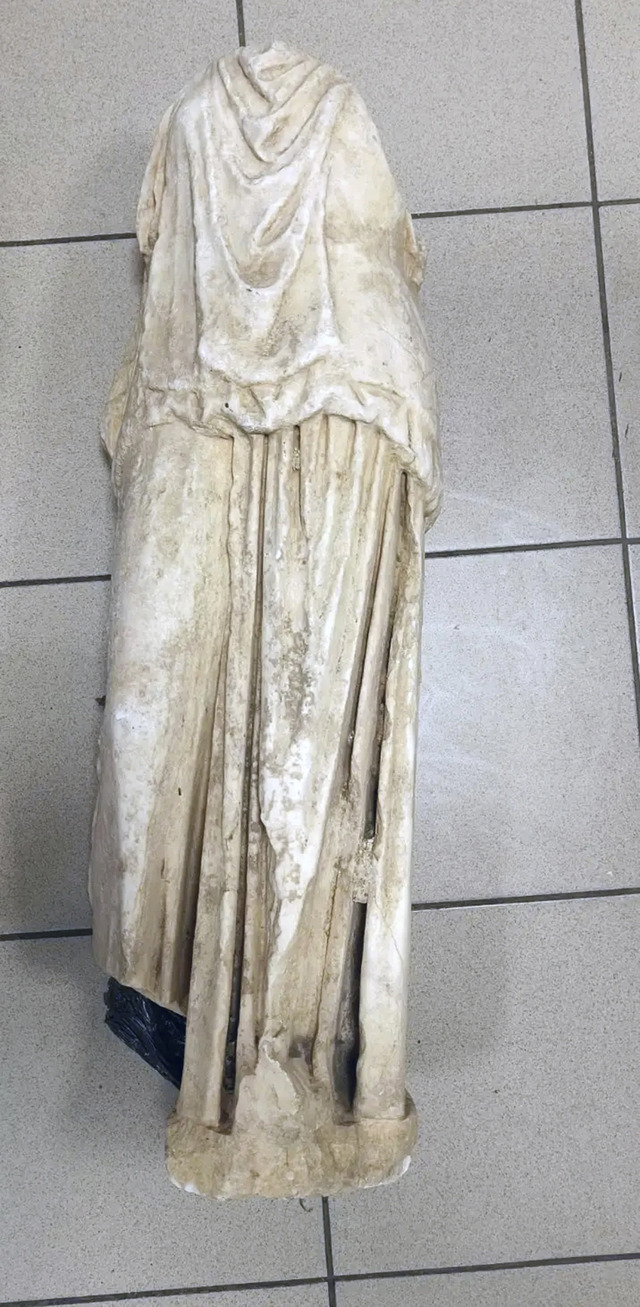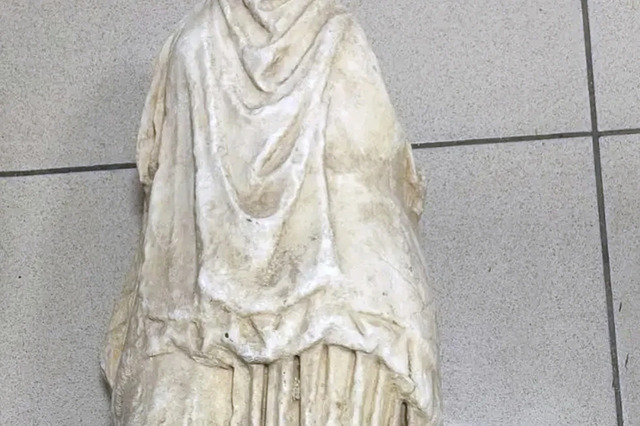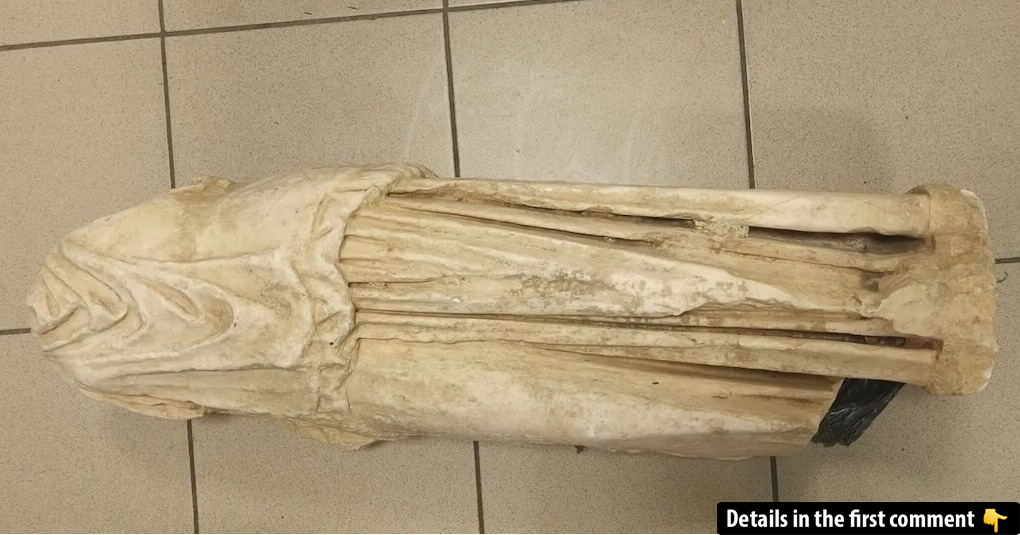In a quiet corner of Thessaloniki, Greece, a discovery that could have easily been lost to time was found in the most unexpected of places: a garbage bag. A 2,000-year-old statue, discarded carelessly, is now rewriting the history of this ancient city. This remarkable find not only sparks questions about its mysterious abandonment but also opens a new chapter in understanding the Hellenistic era and the complex past of Greece’s cultural heritage.
The Discovery: From Garbage to Treasure
The statue, measuring 80 centimeters in height, was discovered by a resident in Neoi Epivates, a suburb located near the bustling city of Thessaloniki. Abandoned carelessly next to a trash bin, this ancient artifact could have easily been lost forever if not for the quick action of a local citizen who immediately turned it over to authorities. Upon receiving the statue, the police contacted archaeologists to assess its significance, sparking an investigation into its origins.

Initial evaluations by experts revealed the statue’s extraordinary age. Dated to the Hellenistic period, between 320 and 30 B.C., it belongs to a time in history when the Greek world flourished in the wake of Alexander the Great’s conquests. This was an era known for its advancements in art, culture, and the spread of Hellenistic influence across vast territories, and the statue serves as a valuable piece of this rich heritage.
Video
Watch the video to learn about the mysterious discovery of a 2,000-year-old Greek statue found in a garbage bag in Thessaloniki. This shocking find will leave you amazed!
The Hellenistic Era: Understanding the Statue’s Origin
The Hellenistic era is a period of Greek history marked by the aftermath of Alexander the Great’s death in 323 B.C. His empire stretched from Greece to Egypt and into the depths of Asia, profoundly shaping the world’s cultural landscape. The art of this period was defined by an emphasis on realism, individuality, and the exploration of more emotional and dramatic themes compared to the classical Greek ideal.

The marble statue found near Thessaloniki is a testament to this style. While it is headless, experts speculate that it may have once represented a goddess, a muse, or a noblewoman, based on the quality of the material and craftsmanship. Its presence near Thessaloniki, a city that was an important cultural and economic hub during the Hellenistic period, raises questions about the city’s role during this time. Thessaloniki itself had a significant role in the ancient world, often serving as a crossroads for trade and cultural exchange between the Greek, Macedonian, and Roman worlds.
Investigating the Origins: The Mystery of the Abandoned Statue
One of the most intriguing aspects of this discovery is the mystery of why the statue was discarded in the first place. In a world where every piece of ancient history is invaluable, how could something so significant be abandoned in such an undignified manner? While police opened an investigation into who might have discarded the statue, it seems that its abandonment is not an isolated incident. Many archaeological discoveries in Greece, particularly in major cities like Thessaloniki, have been made in unusual and unexpected circumstances.
The practice of discarding or hiding valuable artifacts is not new. In times of war, economic decline, or even cultural shifts, valuable items were often buried, hidden, or thrown away. Some historians suggest that the statue may have been kept in a private collection or as part of a hidden treasure, only to be discarded later, either due to neglect, ignorance, or as part of a larger effort to rid the area of unwanted historical items. While we may never know the exact reasons behind this particular abandonment, it serves as a poignant reminder of how fragile the preservation of our history can be.

Accidental Archaeology: The Role of Unplanned Discoveries in Greek Heritage
Accidental discoveries, such as the one involving this marble statue, are relatively common in Greece. The country’s ancient history is buried deep beneath the ground, often unnoticed and unappreciated until construction projects or development work accidentally unearths these treasures. Just last year, workers installing natural gas pipelines near Athens unearthed a Roman-era statue of Hermes, and excavations for Thessaloniki’s metro system uncovered a wealth of antiquities, including Roman roadways and thousands of artifacts spanning multiple eras.
These discoveries underscore the richness of Greece’s historical past, which continues to surprise and astonish archaeologists. While the construction of modern infrastructure sometimes poses a threat to ancient sites, it can also reveal valuable insights into ancient life. Such unplanned discoveries contribute significantly to the ongoing exploration of Greece’s archaeological landscape and have helped reshape our understanding of the region’s ancient civilizations.
Recent Excavations: A Continued Legacy of Uncovering the Past
The 2,000-year-old statue found in Thessaloniki is not the first significant discovery in the region. In fact, the city has long been a hub for archaeological excavation, with numerous sites yielding important artifacts that help illuminate the ancient world. The uncovering of this statue is part of a broader trend of increasing archaeological activity in the area, as ongoing excavation projects continue to unveil the region’s hidden past.
In addition to the metro system excavations, which have brought to light a trove of Roman-era relics, ongoing research in Thessaloniki and the surrounding areas is revealing more about the city’s role as a crossroads of ancient civilizations. This includes further insights into the interactions between the Greeks, Romans, and other peoples that once inhabited the region. As the archaeological community continues to work in this area, we can expect more discoveries that will continue to shape our understanding of ancient Greece and its lasting influence on the modern world.
Conclusion: The Importance of Preserving Greece’s Ancient Legacy
The accidental discovery of the marble statue in Thessaloniki serves as both a triumph and a warning. While it is a remarkable find, it also highlights the fragility of our cultural heritage and the need to protect and preserve these artifacts for future generations. The statue’s journey from a discarded object to a valuable historical artifact is a testament to the enduring importance of archaeology in unraveling the mysteries of the past.
As Greece continues to modernize and develop, it is essential that the importance of preserving its ancient history is not forgotten. From the streets of Thessaloniki to the ruins of Athens, the treasures of the ancient world are all around us, waiting to be discovered. Each new find—whether accidental or deliberate—brings us one step closer to understanding the rich and complex tapestry of civilizations that have shaped the world we live in today.



